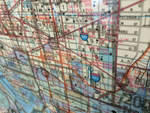Although built by and named after a rival of the Medici—the merchant Luca Pitti—in the 1450s, this gigantic palazzo soon came into Medici hands. It was the Medici family’s principal home from the 1540s, and continued to house Florence’s rulers until 1919. The Pitti contains five museums, including one of the world’s best collections of canvases by Raphael. Out back are elegant Renaissance gardens, the Boboli.
In the art-crammed rooms of the Pitti’s Galleria Palatina, paintings are displayed like cars in a parking garage, stacked on walls above each other following the Enlightenment method of exhibition. Rooms are alternately dimly lit or garishly bright. This is how many of the world’s great art treasures were seen and enjoyed by their original commissioners.
You will find important historical treasures amid the Palatina’s vast and haphazard collection; some of the best efforts of Titian, Raphael, and Rubens line the walls. Botticelli and Filippo Lippi’s “Madonna and Child” (1452) provide the key works in the Sala di Prometeo (Prometheus Room). The latter looks suspiciously like another portrait of his nun/lover, Lucrezia Buti.
Two giant canvases of the “Assumption of the Virgin,” both by Mannerist painter Andrea del Sarto, dominate the Sala dell’Iliade (Iliad Room). Here you will also find another Biblical woman painted by Artemisia Gentileschi, “Judith.”
The Sala di Saturno (Saturn Room) overflows with Raphaels; in the Sala di Giove (Jupiter Room) is his sublime, naturalistic portrait of “La Velata,” as well as “The Ages of Man." The current attribution of the latter painting is awarded to Venetian Giorgione, although this has been disputed.
At the Appartamenti Reali (Royal Apartments) you get a feeling for the conspicuous consumption of the Medici Grand Dukes and their Austrian and Belgian Lorraine successors—and see some notable paintings in their original, ostentatious setting. Italy’s first king lived here for several years during the 19th-century unification process—when Florence was the second national capital, after Turin—until Rome was finally conquered and the court moved there. Much of the gilded stucco, fabrics, and general decoration is in thunderously poor taste.
The Pitti’s “modern” gallery, the Galleria d’Arte Moderna, has a good collection of 19th-century Italian paintings with a focus on Romanticism, Neoclassical works, and the Macchiaioli, a school of Italian painters who worked in an “impressionistic style” chronologically before the French Impressionists. Highlights hunters with limited time should head straight for Sala 18 through 20, where landscapes by Giovanni Fattori (1825–1908) and Telemaco Signorini (1835–1901) hang.
The Pitti’s two lesser museums—the Galleria del Costume (Costume Gallery) and Museo degli Argenti (Museum of Silverware)—combine to show that wealth and taste do not always go hand in hand. One thing you will notice in the Costume Gallery: how much smaller locals were a few centuries ago.





 About our rating system
About our rating system


